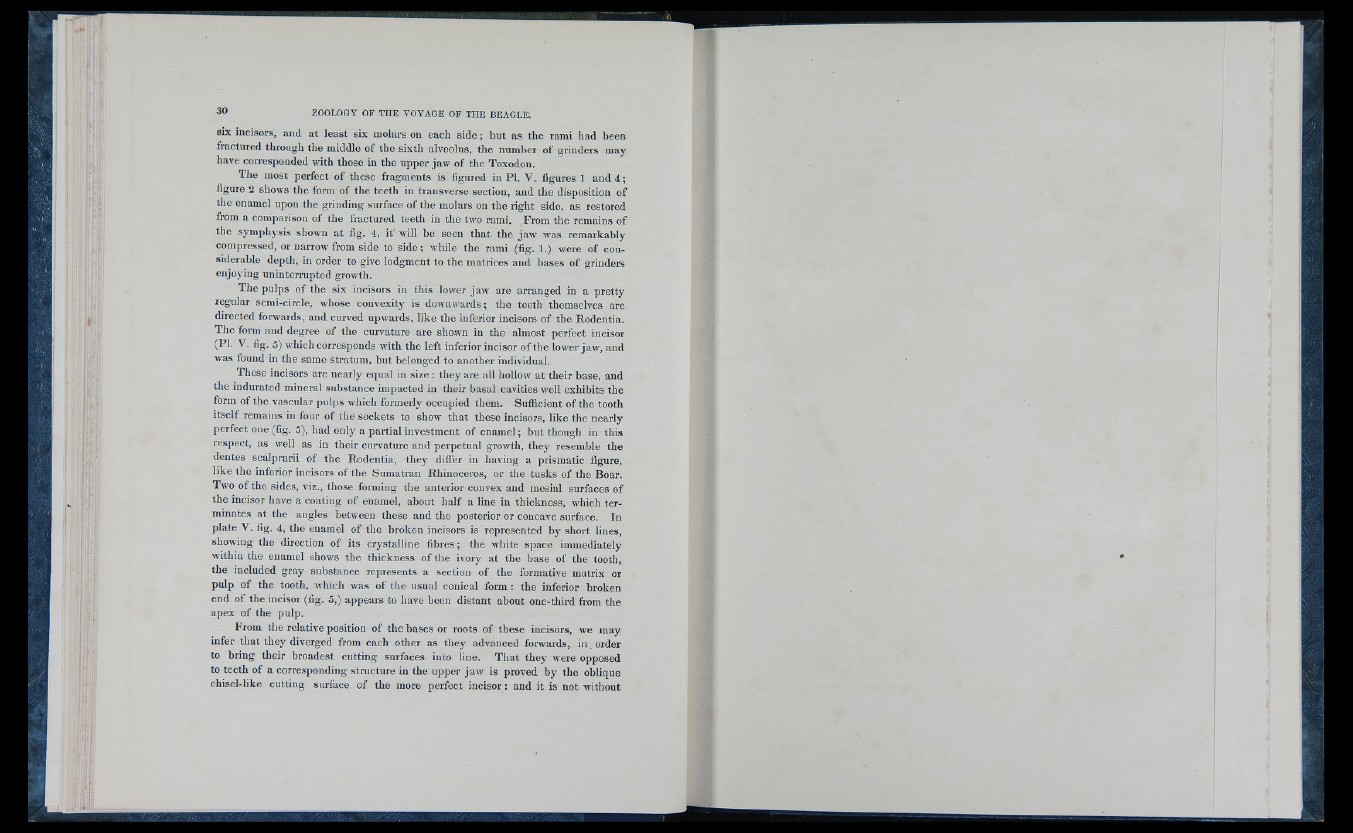
s ix incisors, and a t lea st six molars on each s id e ; but a s the rami had been
fractured through the middle o f the six th alveolus, the number o f grinders may
have corresponded with those in the upper jaw o f the Toxodon.
The most perfect o f these fragments is figured in PI. V. figures ] and 4 ;
figure 2 shows the form o f the teeth in transverse section, and the disposition o f
the enamel upon the grinding surface o f the molars on the right side, as restored
from a comparison o f the fractured teeth in the two rami. From the remains o f
the sym ph y sis shown at fig. 4, it' will be seen that the jaw was remarkably
compressed, or narrow from side to s id e ; vdiile the rami (fig. 1.) were o f considerable
depth, in order to give lodgment to the matrices and bases o f grinders
enjoying uninterrupted growth.
The pulps o f the six incisors in this lower jaw are arranged in a pretty
regular semi-circle, whose convexity is downwards; the teeth themselves are
directed forwards, and curved upwards, like the inferior incisors o f the Rodentia.
The form and degree o f the curvature are shown in the almost perfect incisor
(PI. V. fig. 5) which corresponds with the le ft inferior incisor o f the lower jaw, and
was found in the same stratum, but belonged to another individual.
These incisors are nearly equal in size : they are all hollow at their base, and
the indurated mineral substance impacted in their basal cavities well exhibits the
form o f the vascular pulps which formerly occupied them. Sufficient o f the tooth
its e lf remains in four o f the sockets to show that these incisors, lik e the nearly
perfect one (fig. 5), had only a partial investment o f en am e l; but though in this
respect, as well as in their curvature and perpetual growth, they resemble the
denies scalprarii o f the Rodentia, they differ in having a prismatic figure,
like the inferior incisors o f the Sumatran Rhinoceros, or the tusks o f the Boar.
Two o f the sides, viz., those forming the anterior convex and mesial surfaces of
the incisor have a coating o f enamel, about h a lf a line in thickness, which terminates
at the angles between these and the posterior or concave surface. In
plate V . fig. 4, the enamel o f the broken incisors is represented by short lines,
showing the direction o f its crystalline fibres; the white space immediately
within the enamel shows the thickness o f the ivory at the base o f the tooth,
the included gray substance represents a section o f the formative matrix or
pulp o f the tooth, which was o f the usual conical form : the inferior broken
end o f the incisor (fig. 5,) appears to have been distant about one-third from the
apex o f the pulp.
From the relative position o f the b a se s or roots o f these incisors, we may
infer that they diverged from each other as th ey advanced forwards, in order
to bring their broadest cutting surfaces into line. That th ey were opposed
to teeth o f a corresponding structure in the upper jaw is proved b y the oblique
chisel-like cutting surface o f the more perfect in c iso r : and it is not without